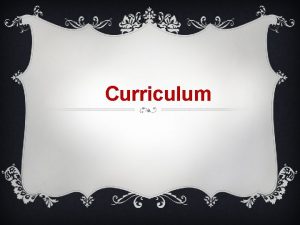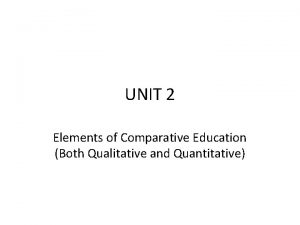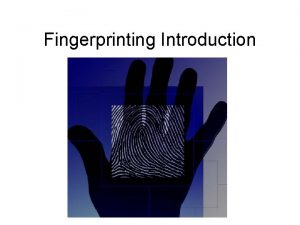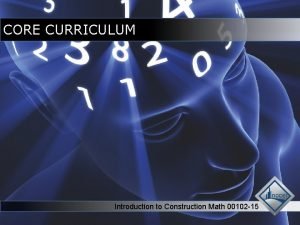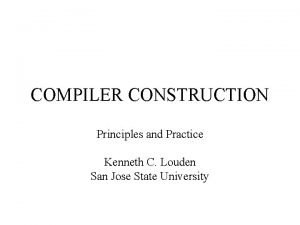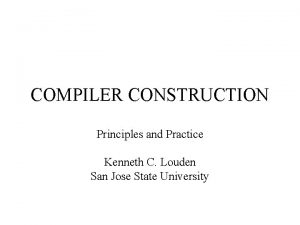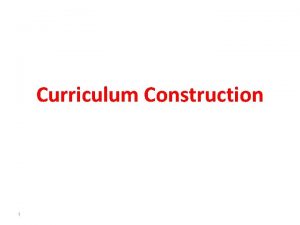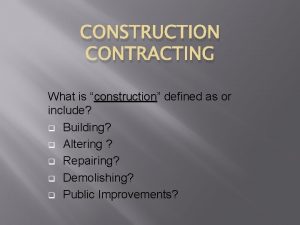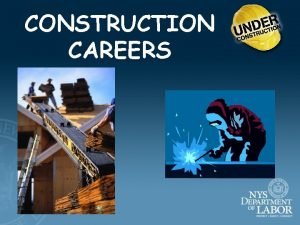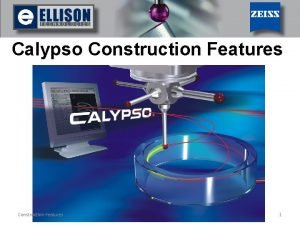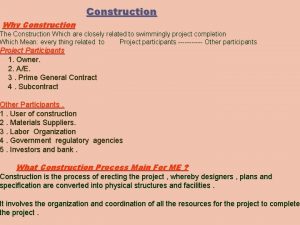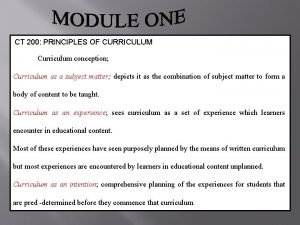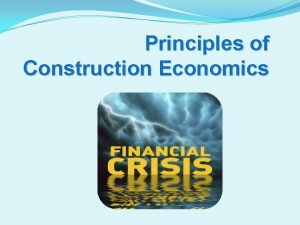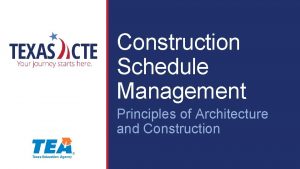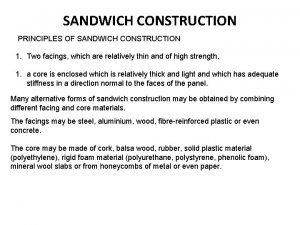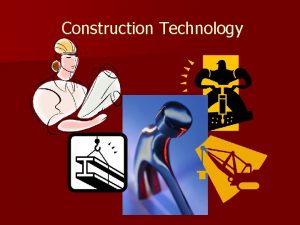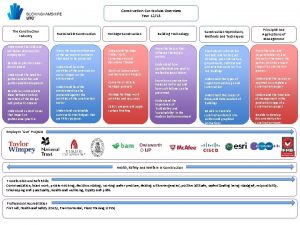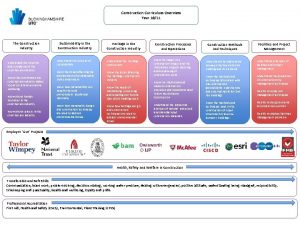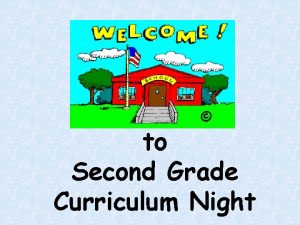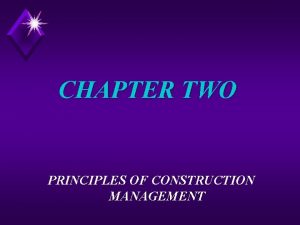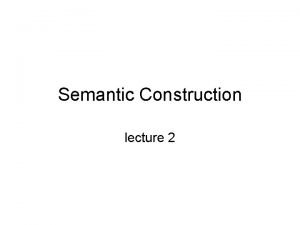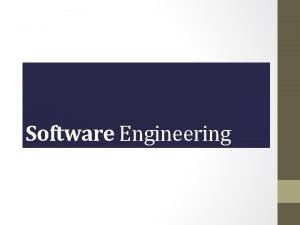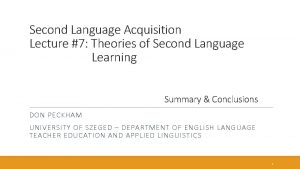Curriculum The Second Lecture Principles of Curriculum Construction





















- Slides: 21

Curriculum

The Second Lecture �Principles of Curriculum Construction �Issues involved in the curriculum construction and implementation �Organization of the Curriculum �Curriculum and Syllabus �Framing of the Curriculum and the Role of the Teachers

Principles of Curriculum Constructions The following principles should be kept in mind when framing a curriculum: 1. The conservative principle 2. The forward-looking principle 3. The creative principle 4. The activity principle 5. Preparation for life 6. Child-centered curriculum 7. Maturity 8. Individual differences 9. Vertical and horizontal articulation

Principles of Curriculum Constructions 10. Linking with life 11. Comprehensiveness and balance 12. Loyalties 13. Flexibility 14. Core or common subjects 15. Leisure 16. All-round development of body, mind and spirit 17. Democracy, secularism and socialism 18. Character building 19. Dignity of labor

1. The Conservative Principle: The function of the school is to preserve and transmit the traditions, knowledge, experience and way of life to the present generation. 2. The forward-looking principle: Future needs and requirements of the community should be given their due place. 3. The creative principle: In a curriculum that is suited to the needs of today and of the future, there must be activities that enable the child to exercise his creative and constructive powers. There must be a definite bias towards definitely creative activities.

4. The activity principle: The curriculum should be thought in terms of activity and experience, rather than of knowledge to be acquired and the facts to be stored. Growth and learning take place only where there is activity. 5. Preparation for life: Education must equip an individual for life. Hence curriculum must include those activities that the child to take his part effectively in the activities of the community and face the various challenges of the future.

6. child-centered curriculum: The best preparation for life we can give a child is to help him to live fully and richly his life. 7. maturity: Curriculum should be adapted to the grade of the pupils and to their stage of mental and physical development. The experience provided should be within the comprehension of the students. 8. Individual differences: The curriculum should be adapted to individual differences. It should not be rigid.

9. Vertical and horizontal articulation: Each year’s course should be built on what has been done in previous years and at the same time should serve as basis for subsequent work. The entire curriculum should be coordinated. 10. Linking with life: The community needs and characteristics should be kept in view while framing the curriculum. 11. Comprehensiveness and balance: The curriculum should be framed in such a way as every aspect of life is given due emphasis.

12. Loyalties: The curriculum should be planned in a manner that it teaches a true sense of loyalty to the family, the school, the community and the world at large. 13. Flexibility: Curriculum should take into consideration the special needs and circumstances of the pupils. 14. Core or common subjects: Core subjects are subjects that are common to all groups of learners. Mother tongue , general science and one craft are expected to be the core subjects.

15. Leisure: The curriculum should prepare the child for the use of leisure time. 16. All-round development of body, mind and spirit: All kinds of experiences should be provided to the students. 17. Democracy, secularism and socialism: Curriculum should train the child to imbibe ideals and values of a democratic, secular and socialist state. 18. Character building: Curriculum should provide those activities and experiences which promote human and social values. 19. Dignity of labour: The students should be provided opportunities to learn from the use of hands.

Issues involved in the curriculum construction and implementation �Why to formulate the curriculum? This includes taking into consideration the aims of education �For whom to formulate the curriculum? It is to be formulated for the learner. It should be formulated according to the various stages , age-groups and the individual differences of the learners.

�What to include in the curriculum? - The contents of the curriculum can be described as “ the environment in motion”. - It includes all the courses, readings, clubs and activities in the school. �Where to use the curriculum? - It is used in and outside the school. - In the classroom, library, laboratory, workshop, playgrounds, and in the numerous informal contacts between teachers and pupils. �When to use the curriculum? - With the different stages of the child. - The motivational aspects may be handled satisfactorily.

�How to use the curriculum? - This involves the knowledge and techniques of various methods of teaching-learning for making the teachinglearning process dynamic, effective and inspirational. �Who is to use the curriculum? - The teacher and the students are the main consumers. �Who is to formulate the curriculum? - Formulation of curriculum is a joint enterprise of several categories of experts in which teachers should play a major role. - The views of the learners should also be given their due importance.

�What type of resources to be used in the curriculum? - A judicious use of the traditional and modern audio- visual aids should be made. �How to evaluate the outcomes of the curriculum implementation? - This is concerned with the success of the learners as well as of the teachers. - Outcomes are evaluated by a number of tests. �How to bring about the required changes in the curriculum? - Curriculum must be evaluated from time to time so as to make it in conformity with the changing needs.

Organization of the Curriculum �Subject-centered curriculum �Experience-centered curriculum

Organization of the Curriculum Subject-centred curriculum Experience-centred curriculum �In terms of subjects �In terms of experiences � It involves round subjects. � It is centred on learners. � Subject matter is invariably � Usually learners doing the selected and organized before the teachinglearning process. � It stresses the teaching of facts, imparting of information. teaching-learning process select and organize the subject matter cooperatively. � It stresses the practical aspects of life.

Organization of the Curriculum Subject-centred curriculum � It is normally isolated from life. � There is little correlation of subjects. � It is very rigid and uniform. Experience-centred curriculum � It is usually correlated with life. � There is lot of correlation of subjects. � It is very flexible and caters to individual differences.

Organization of the Curriculum - Both types of curriculum have their own limitations. - The ideal way will be to introduce as many experiences as possible in the subject curriculum so that the bookish knowledge is supplemented by experiences.

Curriculum & Syllabus Curriculum Syllabus - It is a wider term. - It includes syllabus also. - It sets out the subjects, some balance between humanities and science, and consistency in the study of subjects, thus facilitating inter-subjects links. - It determines the amount of school time allotted to each subject, the aim of teaching each subject, the place of motor skills which take time to acquire. - It includes types of activities and experiences to be provided. - It includes the basic content of a given subject. - The syllabus to be taken up is given week wise and term wise.

Framing of the Curriculum & the Role of the Teachers �Curriculum preparation is a joint venture of persons - and institutions at various levels : Curriculum experts - non-school educators School boards - students (in very rare cases) Educational researches - heads of schools Teacher educators -Teachers Parents - university teachers Publishers State departments of education representatives of industry and trade

The role of the teachers in framing the curriculum �The teachers must play a major role in the curriculum construction. �But it is no feasible to involve each teacher. �Their representatives only can be associated in the formation of the curriculum. �Before the introduction of the curriculum, try-outs may be conducted in selected schools and feedback obtained from the experiences of the teachers. �A few workshops of teachers may also be held. �The teacher must be allowed a reasonable freedom to experiment with the curriculum.
 Principle of curriculum construction
Principle of curriculum construction Secondary education commission 1952-53
Secondary education commission 1952-53 01:640:244 lecture notes - lecture 15: plat, idah, farad
01:640:244 lecture notes - lecture 15: plat, idah, farad Project planning begins with the melding of
Project planning begins with the melding of 186 282 miles per second into meters per second
186 282 miles per second into meters per second Principles of economics powerpoint lecture slides
Principles of economics powerpoint lecture slides Demonstration method of teaching
Demonstration method of teaching Accounting principles second canadian edition
Accounting principles second canadian edition Accounting principles second canadian edition
Accounting principles second canadian edition Accounting principles second canadian edition
Accounting principles second canadian edition Accounting principles second canadian edition
Accounting principles second canadian edition Tented arch
Tented arch Konstruksi kurikulum adalah
Konstruksi kurikulum adalah Introduction to construction math
Introduction to construction math Compiler construction principles and practice
Compiler construction principles and practice Compiler construction: principles and practice
Compiler construction: principles and practice Fundamental principles of ship construction
Fundamental principles of ship construction Hát kết hợp bộ gõ cơ thể
Hát kết hợp bộ gõ cơ thể Ng-html
Ng-html Bổ thể
Bổ thể Tỉ lệ cơ thể trẻ em
Tỉ lệ cơ thể trẻ em Gấu đi như thế nào
Gấu đi như thế nào
